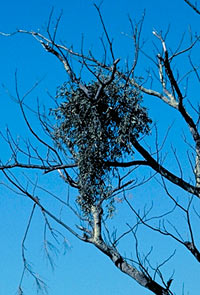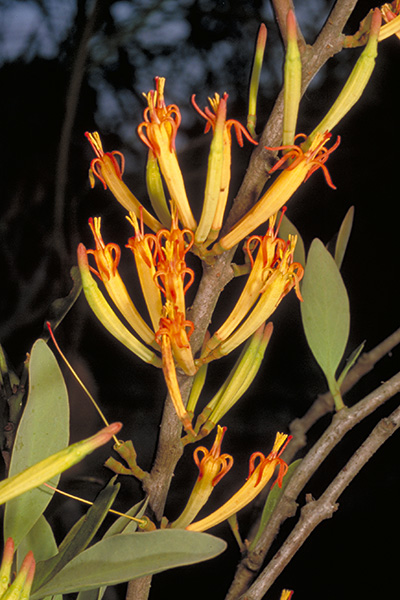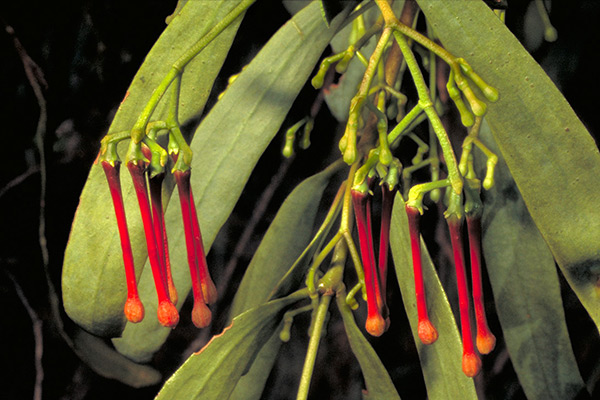
The Misunderstood Mistletoe
Lesley Waite
When at Burrendong Arboretum (near Wellington, New South Wales), I was struck by the number of mistletoes that we saw in the eucalypts there. Not knowing much about them, I thought I'd do a bit of research. This is what I found out:
- Contrary to their much-maligned image, none are weeds, none are introduced. They exist in all ecosystems where there are trees.
- Mistletoes are semi-parasitic native plants. They undertake photosynthesis to produce organic matter, but derive water and mineral nutrients from their host. There are 85 species of Australian mistletoe, mainly in the Loranthaceae family.
- They are very efficient organisms - there is better food value in mistletoes than in the host tree, so they are more attractive to birds and animals. They usually mimic the host, and sometimes the mimicry is so close that they are almost impossible to detect, eg. the she-oak mistletoe (Amyema cambagei) on Casuarina glauca. Amongst eucalypts they can be distinguished by the thickening of leaf distribution, and the sometimes olive green, sometimes purplish colouring.
- Mistletoes are mainly spread by the tiny Mistletoe bird. The fruits are edible when ripe, having a sticky, gelatinous glucose-rich pulp around a single seed. The stickiness of the seed helps them adhere to the branches of the trees when the birds are finished with them.
- Mistletoes contribute much to the ecosystem in which they grow:
- Birds depend on the mistletoes' highly nutritious nectar and fruit for food. Many native birds, including honeyeaters, lorikeets, bowerbids, emus and cockatoos are known to feed on them. Fluffy gliders supplement their diet with clumps of nectar-rich mistletoe flowers and possums also feed on fruit and flowers.
- Possums, koalas, sheep, cattle and many insects also graze on the leaves.
- The dense leafy clumps also make ideal nesting sites for many birds, as they are protected from bad weather and predators. Many bird species, including the endangered Regent Honeyeater, prefer nesting in mistletoe clumps.
- There are about 25 species of butterflies which feed on mistletoes during the larval or caterpillar stage.
- Mistletoes like lush, healthy trees, so they may be considered an 'indicator plant' for environmental health - their presence can be a good sign. Australian mistletoes are not well equipped to cope with drought and are sensitive to fire, so bushfires prevent their spread. It has also been suggested that possums contribute a major restraint on mistletoe growth.
So do mistletoes kill trees?
Mistletoe, like anything in our environment, can tilt beyond equilibrium. Tim Low in his most recent book, 'The New Nature', observes:
"Native mistletoes also kill trees...where scattered eucalypts grow on farms and along roads, away from bushfires and brushtails. Foxes, by preying on mistletoe-munching possums, help them [the mistletoes] succeed. Inside forests these parasites rarely kill trees, but on farms they kill hundreds."
 |
 |
 |
| Mistletoes often have a distinctive 'clumping shape (left). They can also have very colourful flowers as shown by Dendrophthoe vitellina on Hakea francisiana (centre) and Amyema miquelii on Alectryon oleifolius, Rosewood (right). |
So it seems the most likely reason for mistletoe becoming a threat to trees is the human activities which have interfered with the natural ecological balance, like excessive tree clearing. Mistletoes certainly appear to having an increasing impact in many parts of Australia, particularly among isolated trees in cleared paddocks and along roadsides, where the parasites have access to more sunshine and so grow stronger, and yet this is where there are fewer available hosts, leaving each tree extremely vulnerable. The mistletoes are, however, still relatively rare in undisturbed bush.
Some 'experts' believe that mistletoes are responsible for tree decline and death and therefore should eradicated. But given the value of mistletoes to such a wide variety of Australian fauna, it would be better to work towards restoring the natural balance, such as fencing the host trees from livestock to encourage regeneration and reduce soil compaction, and/ or planting local understorey plants to provide habitat for mistletoe predators. Bringing the mistletoe back into balance will keep the remaining vegetation healthy. This makes far more sense than eradicating the mistletoe, and along with it the valuable contribution that it makes to the country's ecology.
From 'Blandfordia', the newsletter of the North Shore Group of the Australian
Plants Society, November 2002.
Australian Plants online - 2006
Association of Societies for Growing Australian Plants
|